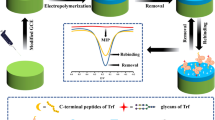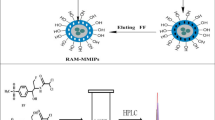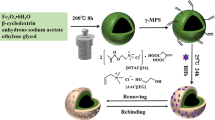Abstract
Transferrin (TrF) is a very important human body glycoprotein and a clinical biomarker which controls the body’s iron ion channels and iron ion balance. Any change in TrF concentration and isoform also reflects the emergence of some diseases. In this work, we prepared magnetic molecularly imprinted nanoparticles (deep eutectic solvent-molecular imprinting polymers [DES-MIPs]) with a deep eutectic solvent (DES) as a functional monomer to separate TrF in human serum. The DES dosage for MIP, pH value, and time for adsorption have been optimized, and these materials show special adsorption properties for TrF. The maximum adsorption capacity (Qmax) and dissociation constant KL of the MIP by the Langmuir adsorption curve (R2 = 0.9949) were 37.5 mg/g and 0.015 g/L, respectively. The imprinting factor of the MIP is 3.50 with relative standard deviation (5.63%). In summary, the use of DES as a functional monomer in molecular imprinting technology provides a novel, efficient, and biocompatible method for the isolation and purification of proteins.

ᅟ












Similar content being viewed by others
References
Steere AN, Miller BF, Roberts SE, Byrne SL, Chasteen ND, Smith VC, et al. Ionic residues of human serum transferrin affect binding to the transferrin receptor and iron release. Biochemistry. 2012;51:686–94.
Kaltashov IA, Bobst CE, Zhang M, Leverence R, Gumerov DR. Transferrin as a model system for method development to study structure, dynamics and interactions of metalloproteins using mass spectrometry. Biochim Biophys Acta. 2012;1820:417–26.
Bou-Abdallah F, Terpstra TR. The thermo dynamic and binding properties of the transferrins as studied by isothermal titration calorimetry. Biochim Biophys Acta. 2012;1820:318–25.
Brandsma ME, Jevnikar AM, Ma SW. Recombinant human transferrin: beyond iron binding and transport. Biotechnol Adv. 2011;29:230–8.
Keenan J, Pearson D, O’Driscoll L, Gammell P, Clynes M. Evaluation of recombinant human transferrin (DeltaFerrinTM) as an iron chelator in serum-free media for mammalian cell culture. Cytotechnology. 2006;51:29–37.
Hoshia K, Matsumotob Y, Itoa H, Saitob K, Hondac T, Yamaguchid Y, et al. A unique glycan-isoform of transferrin in cerebrospinal fluid: a potential diagnostic marker for neurological diseases. Biochim Biophys Acta Gen Subj. 2017;1861:2473–8.
Caslavska J, Joneli J, Wanzenried U, Schiess J, Thormann W. Transferrin immunoextraction for determination of carbohydrate-deficient transferrin in human serum by capillary zone electrophoresis. J Sep Sci. 2012;35:3521–8.
Grönwall C, Sjöberg A, Ramström M, Guthenberg IH, Hober S, Jonasson P, et al. Affibody-mediated transferrin depletion for proteomics applications. Biotechnol J. 2007;2:1389–98.
Qian ZM, Li HY, Sun HZ, Ho K. Targeted drug delivery via the transferrin receptor-mediated endocytosis pathway. Pharmacol Rev. 2002;54:561–87.
Daniels TR, Bernabeu E, Rodríguez JA, Patel S, Kozman M, Chiappetta D, et al. The transferrin receptor and the targeted delivery of therapeutic agents against cancer. Biochim Biophys Acta. 2012;1820:291–317.
Soni V, Jain SK, Kohli DV. Potential of transferrin and transferrin conjugates of liposomes in drug delivery and targeting. Am J Drug Deliv. 2005;3:155–70.
Ghanbari Z, Housaindokht MR, Bozorgmehr MR, Izadyar M. The effect of glycosylation on the transferrin structure: a molecular dynamic simulation analysis. J Theor Biol. 2016;404:73–81.
Lata K, Sharma R, Naik L, Rajput YS, Mann B. Synthesis and application of cephalexin imprinted polymer for solid phase extraction in milk. Food Chem. 2015;184:176–82.
Yue G, Yan X, Cong L, Bo Z, Li Y, Liu W. Biomimetic sensor based on molecularly imprinted polymer with nitroreductase-like activity for metronidazole detection. Biosens Bioelectron. 2016;77:393–9.
Rico-Yuste A, Walravens J, Urraca JL, Abou-Hany RAG, Descalzo AB, Orellana G, et al. Analysis of alternariol and alternariol monomethyl ether in foodstuffs by molecularly imprinted solid-phase extraction and ultra-high-performance liquid chromatography tandem mass spectrometry. Food Chem. 2018;243:357–64.
Liu L, Zhong T, Xu QQ, Chen Y. Efficient molecular imprinting strategy for quantitative targeted proteomics of human transferrin receptor in depleted human serum. Anal Chem. 2015;87:10910–9.
Liu MM, Pi JY, Wang XJ, Huang R, Du YM, Yu XY, et al. A sol-gel derived pH-responsive bovine serum albumin molecularly imprinted poly (ionic liquids) on the surface of multiwall carbon nanotubes. Anal Chim Acta. 2016;932:29–40.
Din MI, Hussain Z, Munir H, Naz A, Intisar A, Makshoof MN. Microwave treated Salvadora oleoides as an eco-friendly biosorbent for the removal of toxic methyl violet dye from aqueous solution—a green approach. Int J Phytoremediation. 2016;18:477–86.
Shaaban H. New insights into liquid chromatography for more eco-friendly analysis of pharmaceuticals. Anal Bioanal Chem. 2016;408:6929–44.
Sebastian P, Torralba E, Valles E, Molina A, Gomez E. Advances in copper electrodeposition in chloride excess. A theoretical and experimental approach. Electrochim Acta. 2015;164:187–95.
Abbott AP, Davies DL, Capper G, Rasheed RK, Tambyrajah V. US, US7183433. 2007.
Shen Y, He X, Hung FR. Structural and dynamical properties of a deep eutectic solvent confined inside a slit pore. J Phys Chem C. 2015;119:24489–500.
Karimi M, Hesaraki S, Alizadeh M, Kazemzadeh A. Synthesis of calcium phosphate nanoparticles in deep-eutectic choline chloride-urea medium: investigating the role of synthesis temperature on phase characteristics and physical properties. Ceram Int. 2016;42:2780–8.
Fu NJ, Lv RQ, Guo ZX, Guo YW, You XY, Tang BK, et al. Environmentally friendly and non-polluting solvent pretreatment of palm samples for polyphenol analysis using choline chloride deep eutectic solvents. J Chromatogr A. 2017;1492:1–11.
Li G, Tang W, Cao W, Wang Q, Zhu T. Imprinted molecule polymer in combination with low eutectic solvents for solid phase extraction of caffeic acid in hawthorn. Chin J Chromatogr. 2015;33:792–8.
Li GZ, Wang W, Wang Q, Zhu T. Deep eutectic solvents modified molecular imprinted polymers for optimized purification of chlorogenic acid from honeysuckle. J Chromatogr Sci. 2016;54:271–9.
Chen HC, Kong J, Yuan DY, Fu GQ. Synthesis of surface molecularly imprinted nanoparticles for recognition of lysozyme using a metal coordination monomer. Biosens Bioelectron. 2014;53:5–11.
Qin L, He XW, Wei Z, Li WY, Zhang YK. Macroporous thermosensitive imprinted hydrogel for recognition of protein by metal coordinate interaction. Z. Yu-Kui. Anal Chem. 2009;81:7206–16.
Liu YJ, Wang YZ, Dai QZ, Zhou YG. Magnetic deep eutectic solvents molecularly imprinted polymers for the selective recognition and separation of protein. Anal Chim Acta. 2016;936:168–78.
Le TTH, Nam NH, Doan DH, Nhung HTM, Quang BT, Nam PH. Folate attached, curcumin loaded Fe3O4 nanoparticles: a novel multifunctional drug delivery system for cancer treatment. Mater Chem Phys. 2016;172:98–104.
Fayazi M, Taher MA, Afzali D, Mostafavi A. Fe3O4and MnO2 assembled on halloysite nanotubes: a highly efficient solid-phase extractant for electrochemical detection of mercury(II) ions. Sensors Actuators B Chem. 2016;228:1–9.
Ge XX, Zhang AD, Lin YH, Du D. Simultaneous immunoassay of phosphorylated proteins based on apoferritin templated metallic phosphates as voltammetrically distinguishable signal reporters. Biosens Bioelectron. 2016;80:201–7.
Ji YS, Yin JJ, Xu ZG, Zhao CD, Huang HY, Zhang HX, et al. Preparation of magnetic molecularly imprinted polymer for rapid determination of bisphenol A in environmental water and milk samples. Anal Bioanal Chem. 2009;395:1125–33.
Li N, Wang YZ, Xu KJ, Huang YH, Wen Q, Ding XQ. Development of green betaine-based deep eutectic solvent aqueous two-phase system for the extraction of protein. Talanta. 2016;152:23–32.
Bie ZJ, Chen Y, Ye J, Wang SS, Liu Z. Boronate-affinity glycan-oriented surface imprinting: a new strategy to mimic lectins for the recognition of an intact glycoprotein and its characteristic fragments. Angew Chem Int Ed. 2015;54:10211–5.
Guo JX, Wang YZ, Liu YJ, Zhou YG. The synthesis of imprinted polymers based on Fe3O4 nanomaterials and the recognition of proteins. Anal Methods. 2015;7:10018–25.
Liu BH, Han MY, Guan GJ, Wang SH, Liu RY, Zhang ZP. Highly-controllable molecular imprinting at superparamagnetic iron oxide nanoparticles for ultrafast enrichment and separation. J Phys Chem C. 2011;115:17320–7.
Righettl PG, Tudor G. Isoelectric points and molecular weights of proteins. Chromatogr Rev. 1981;220:115–94.
Zhang M, Wang YZ, Jia XP, He MZ, Xu ML, Yang S, et al. The preparation of magnetic molecularly imprinted nanoparticles for the recognition of bovine hemoglobin. Talanta. 2014;120:376–85.
Wei JR, Ni YL, Zhang W, Zhang ZQ, Zhang J. Detection of glycoprotein through fluorescent boronic acid-based molecularly imprinted polymer. Anal Chim Acta. 2017;960:110–6.
Funding
This research was financially supported by the National Natural Science Foundation of China (No. 21575055 and 21375052) and the Research Funds for the Central Universities (lzujbky-2017-k09).
Author information
Authors and Affiliations
Corresponding author
Ethics declarations
The study using serum as sample has been approved by the people’s hospital of Gansu province Ethics Committee and the Lanzhou University Ethics Committee and has been performed in accordance with the ethical standards. Informed consent was obtained from all individual participants included in the study.
Conflict of interest
The authors declare that they have no conflict of interest.
Rights and permissions
About this article
Cite this article
Zhang, Y., Cao, H., Huang, Q. et al. Isolation of transferrin by imprinted nanoparticles with magnetic deep eutectic solvents as monomer. Anal Bioanal Chem 410, 6237–6245 (2018). https://doi.org/10.1007/s00216-018-1232-2
Received:
Revised:
Accepted:
Published:
Issue Date:
DOI: https://doi.org/10.1007/s00216-018-1232-2




